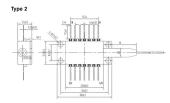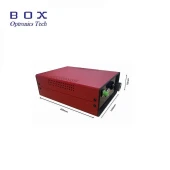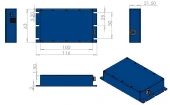Description
Our tunable lasers are crafted using our patented innovative tunable fiber Bragg grating (FBG) technology, setting a new standard in precision and reliability. These fiber lasers feature "all-fiber" connections within, ensuring a seamless and low-loss laser cavity that delivers exceptional performance. With a high optical signal-to-noise ratio exceeding 75dB, these lasers provide unparalleled clarity and precision in their output. The design is compact and robust, offering a narrow line width and low noise, making them ideal for a variety of demanding applications.
The versatility of our laser systems is further enhanced by additional output and input terminals, allowing them to function as an ASE source, an amplifier, or a tunable FBG. This adaptability ensures that our lasers can meet a wide range of requirements, providing users with the flexibility they need. Additionally, by utilizing tunable FBGs, a fiber pigtailed semiconductor laser can be configured for external cavity wavelength tuning, expanding its potential uses.
Our commitment to innovation and quality is backed by patents in both the United States (US 7801403) and China (ZL 2008 1 0211470.7), reflecting our dedication to pioneering technology in the field of fiber optics. For those seeking custom wavelength solutions, our team is ready to assist, ensuring that each laser system is tailored to meet specific needs.
Tunable Fiber Laser 1550nm
Specifications
| Center Wavelength: | 1550 nm |
|---|---|
| Output Power: | 0.1 W |
| Output Mode: | Not Specified |
| Beam Quality (M^2): | 1.05 |
| Output Fiber Type: | Other / Non-specified |
| Interface: | Other / Not-specified |
| Cooling: | Other |
| Electrical Requirements: | Other / Not Specified |
| Wavelength Tuning Range:: | 25~30 nm |
| Optical S/N:: | 75dB |
Features
- Innovative Tunable Fiber Bragg Grating (FBG) Technology: Our lasers utilize patented FBG technology for precise wavelength tuning.
- All-Fiber Connections: Designed with seamless all-fiber connections for a compact and robust system.
- Large Tuning Range: Offers a typical tuning range of over 25 nm, extending up to 50 nm.
- High Optical S/N Ratio: Features a high optical signal-to-noise ratio greater than 75 dB, ensuring low noise and high performance.
- Versatile Output Ports: Equipped with tunable FBG and ASE source output ports for flexible applications.
- Compact Design: The laser system measures 151 x 116 x 51 mm, making it ideal for space-constrained environments.
- Patented Technology: Protected by US Patent 7801403 and China Patent ZL 2008 1 0211470.7.
Applications
- Telecommunications: Utilize the tunable lasers for wavelength division multiplexing (WDM) systems to enhance data transmission efficiency and capacity.
- Sensing Applications: Implement in fiber optic sensors for precise measurements in industries such as oil and gas, structural health monitoring, and environmental sensing.
- Medical Diagnostics: Apply in optical coherence tomography (OCT) for high-resolution imaging in medical diagnostics and research.
- Research and Development: Use the lasers in laboratories for experiments requiring precise wavelength tuning and stability.
- Metrology: Employ in precision metrology applications for accurate measurements and calibration in scientific and industrial settings.
- Military and Aerospace: Integrate into systems requiring robust and reliable laser sources for communication and sensing in challenging environments.
- Optical Testing and Characterization: Use as a versatile tool for testing and characterization of optical components and systems.
- Optical Amplification: Serve as an amplifier in optical networks to boost signal strength and extend transmission distances.
Frequently Asked Questions
How can I get a custom wavelength for this tunable fiber laser?
What are the features of this tunable fiber laser?
What can this tunable fiber laser be used for?
What is a tunable fiber laser?
What is the typical tuning range of this tunable fiber laser?
Similar Products












Your inquiry has been received.
Create an account by adding a password
Why create an account?
- Auto-complete inquiry forms
- View and manage all your past messages
- Save products to your favorites
- Close your account anytime — no hassle
